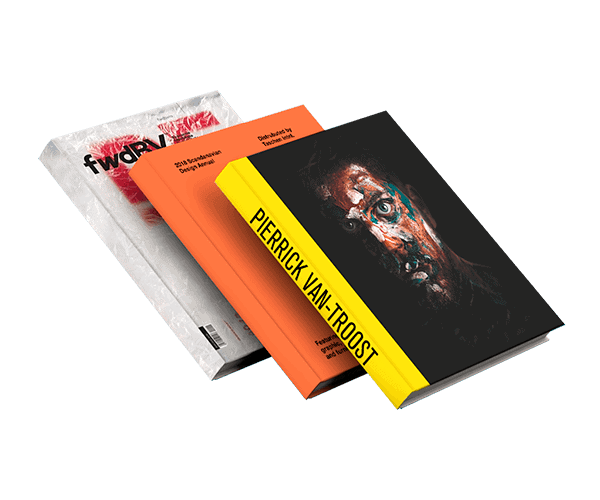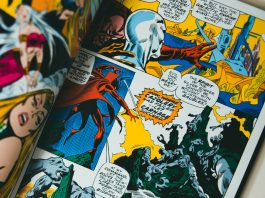Last updated on August 6th, 2024 at 02:07 pm
Hardcover binding is the gold standard of bookbinding, offering features that other types of binding can’t match. Yet, it is not always the best choice for a print project. To understand the benefits of hardcover books and when to choose hardcover binding, let’s look at the other types of binding currently available and see how they compare to hardcover binding. We’ll also answer the question, “Do hardcover books last longer?”

The most common types of bookbinding
The modern print industry offers a wide variety of printing methods. The most popular include:
- Saddle stitched. A very economical binding method, it punches wire through the outside spine of the book and runs it through the inside centerfold to grip the pages.
- Perfect bound. This involves gluing the pages of the book to a spine and then attaching a cover. It’s called “perfect” because the pages and the cover are all cut to the exact same size, allowing them to line up perfectly during the binding process.
- Spiral/coil bound. To hold the pages, a plastic coil is threaded through punched holes, and the ends are crimped to prevent the plastic coil from slipping off.
- Wire-O. Formed wire is threaded through punched holes, allowing books to lay flat when open.
These binding techniques work well with a wide range of print projects, from small to large. Their price also tends to be more economical than hardcover. Yet, they don’t match the durability or the solid feel of a classic hardcover book.
The hardcover binding process
Hardcover binding is a longer and more complex binding process. It also has more components than the binding methods listed above. These include:
- Cover. The cover is a key ingredient in giving hardcover books their durability. It consists of cardboard and a gloss or matte laminated printed text stock.
- Endsheet. This is a white piece of paper that gets glued to the inside cover of the book.
- Flyleaf. The flyleaf is a blank page next to the endsheet. It is not glued to the cover.
- Hinge. An area next to the spine that bends when the book is opened. The hinge allows the book to open freely without causing damage to the spine.
The hardcover binding process we use at Printivity is simple- yet elegant. The covers are printed on a sheet large enough to cover the front, spine, and back cover. Once printed, the covers are laminated with the customer’s choice of gloss or matte lamination. Then the laminated paper covers are attached to the cardboard. The interior content is printed, cut down to the final dimension, and glued together using PUR glue, which is the strongest glue in the industry – 50% stronger traditional than tradition EVA glue.
The advantages of hardcover binding
There are many benefits of hardcover books over other types of binding like paperback, but two stand out above all else – quality and durability. But, how long do hardcover books last? Let’s just say that, whether they sit on the bookshelf unread for long periods of time or receive constant use, they are made to withstand the test of time.
Compared to other options like perfect binding, hardcover binding stands out for a variety of reasons, including its ability to give books their own unique look and feel. This is accomplished by offering a wide variety of special finishing options not available with other types of binding.
Your manuscript needs to have between 30 to 400 pages to reap the benefits of hardcover books binding. As long as it meets these parameters, hardcover binding offers a high degree of versatility, making it ideal for almost any type of printing project. You’ll find it is especially appropriate for different types of hardcover books that will be treasured for years, such as yearbooks, art books, coffee table books, and children’s books. It is also the binding of choice for professional books, including law books, medical texts, engineering, or architectural books. Hard-cover binding is also a good choice for self-published books, as it lends an aura of credibility for authors and a touch of class to the finished product.
When to choose hardback binding
Now that we know the benefits of hardcover books, we get down to answering the question: when is the right time to choose hardcover binding? The answer depends on a number of factors. At Printivity, we recommend going with a hardcover binding when you want a book that will:
- Have a long shelf life
- Look great whether out on the coffee table or sitting on the bookshelf
- Make a statement with a professional look and feel
- Have a lot of color images that you want to stand out on the page
- Be protected from wear and tear
- Be a treasured keepsake (i.e., yearbooks)
- Have a customizable spine that can be seen from a bookshelf
- Have the option of laminated covers that gives the book additional protection and gives a more professional look
Conditions that would be better suited for other binding options include:
- The book is less than 30 pages
- You have a limited budget
- The content will be frequently updated
- You plan on disposing of the book after it is no longer needed
- The book will need to be sent using direct mail services
- The book will need to lay completely flat
The bottom line is that finishing your book with a hardcover gives it a distinguished look readers appreciate while helping protect it over time. From fiction to biographies, how-to books and everything in between, hardcover binding is a great choice for all kinds of books.
If you are still unsure if a hardcover book is the right choice for you and would like to learn more, call us at 1-877-649-5463. Our Customer Service Representatives are here to help!




